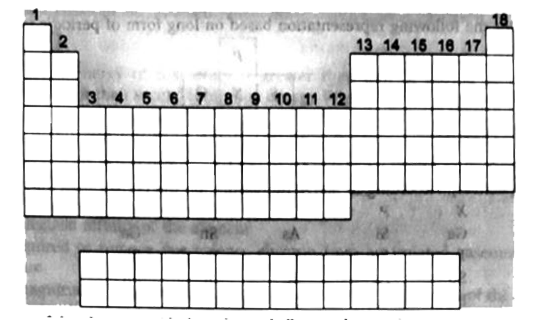Write the ground state electronic configuration of F+2.
To write the ground state electronic configuration of the F+2 ion, we will follow these steps:
Step 1: Determine the number of electrons
Fluorine (F) has an atomic number of 9, which means a single fluorine atom has 9 electrons. Therefore, F2 (which consists of two fluorine atoms) will have:
2×9=18 electrons
Since F+2 has lost one electron, it will have:
18−1=17 electrons
Step 2: Write the molecular orbital energy levels
According to molecular orbital theory, the order of filling for the molecular orbitals for diatomic molecules like F2 is as follows:
1. σ1s
2. σ∗1s
3. σ2s
4. σ∗2s
5. σ2pz
6. π2px=π2py
7. π∗2px=π∗2py
8. σ∗2pz
Step 3: Fill the molecular orbitals with 17 electrons
Now we will fill these molecular orbitals with the 17 electrons, following the Pauli exclusion principle and Hund's rule:
1. Fill σ1s with 2 electrons: σ1s2
2. Fill σ∗1s with 0 electrons: σ∗1s0
3. Fill σ2s with 2 electrons: σ2s2
4. Fill σ∗2s with 0 electrons: σ∗2s0
5. Fill σ2pz with 2 electrons: σ2p2z
6. Fill π2px and π2py with 4 electrons (2 in each): π2p2xπ2p2y
7. Fill π∗2px and π∗2py with 1 electron (1 in one of them): π∗2p1xπ∗2p0y
8. Fill σ∗2pz with 0 electrons: σ∗2p0z
Step 4: Write the final electronic configuration
Combining all the filled orbitals, the ground state electronic configuration of F+2 can be written as:
σ1s2σ∗1s0σ2s2σ∗2s0σ2p2zπ2p2xπ2p2yπ∗2p1xπ∗2p0yσ∗2p0z
This can be simplified to:
σ1s2σ∗1s0σ2s2σ∗2s0σ2p2zπ2p2xπ2p2yπ∗2p1x
Fluorine (F) has an atomic number of 9, which means a single fluorine atom has 9 electrons. Therefore, F2 (which consists of two fluorine atoms) will have:
2×9=18 electrons
Since F+2 has lost one electron, it will have:
18−1=17 electrons
According to molecular orbital theory, the order of filling for the molecular orbitals for diatomic molecules like F2 is as follows:
1. σ1s
2. σ∗1s
3. σ2s
4. σ∗2s
5. σ2pz
6. π2px=π2py
7. π∗2px=π∗2py
8. σ∗2pz
Now we will fill these molecular orbitals with the 17 electrons, following the Pauli exclusion principle and Hund's rule:
2. Fill σ∗1s with 0 electrons: σ∗1s0
3. Fill σ2s with 2 electrons: σ2s2
4. Fill σ∗2s with 0 electrons: σ∗2s0
5. Fill σ2pz with 2 electrons: σ2p2z
6. Fill π2px and π2py with 4 electrons (2 in each): π2p2xπ2p2y
7. Fill π∗2px and π∗2py with 1 electron (1 in one of them): π∗2p1xπ∗2p0y
8. Fill σ∗2pz with 0 electrons: σ∗2p0z
Combining all the filled orbitals, the ground state electronic configuration of F+2 can be written as:
σ1s2σ∗1s0σ2s2σ∗2s0σ2p2zπ2p2xπ2p2yπ∗2p1xπ∗2p0yσ∗2p0z
σ1s2σ∗1s0σ2s2σ∗2s0σ2p2zπ2p2xπ2p2yπ∗2p1x
Topper's Solved these Questions
- CHEMICAL BONDING AND MOLECULAR STRUCTUREBOOK - ICSECHAPTER - CHEMICAL BONDING AND MOLECULAR STRUCTUREEXERCISE - VERY SHORT ANSWER TYPE QUESTIONS
50 Videos
- CHEMICAL BONDING AND MOLECULAR STRUCTUREBOOK - ICSECHAPTER - CHEMICAL BONDING AND MOLECULAR STRUCTUREEXERCISE - SHORT ANSWER TYPE QUESTIONS
76 Videos
- CHEMICAL BONDING AND MOLECULAR STRUCTUREBOOK - ICSECHAPTER - CHEMICAL BONDING AND MOLECULAR STRUCTUREEXERCISE - NCERT TEXT-BOOK EXERCISES ( WITH HINTS AND SOLUTIONS)
47 Videos
- CHEMICAL THERMODYNAMICS BOOK - ICSECHAPTER - CHEMICAL THERMODYNAMICS EXERCISE - NCERT TEXT-BOOK. EXERCISES
22 Videos
Similar Questions
Knowledge Check
Magnesium reacts with an element (x) to form an ionic compound. If the ground state electronic configuration of (X) is 1s22s22p3, the simplest formula for this compound is
AMg2X3BMgX2CMg2XDMg3X2The ground state electronic configuration of S is 3s23p4 . How does it form the compound SF6 ?
ADue to octahedral shape of S atomsBDue to presence of vacant 3d- orbitals which provide 6 unpaired electrons in excited stateCDue to sp3 hybridisation of S atom which provides 6 electrons to 6 F atomsDDue to presence of 3 sigma and 3 pi bonds between S and F
Write down the electronic configuration of: Ce4+
View SolutionFrom the ground state, electronic configuration of the elements given below, pick up the one with highest value of second ionization energy:
View SolutionFrom the ground state electronic configuration of the elements given below, pick up the one with the highest value of second ionisation energies
View SolutionThe representation of the ground state electronic configuration of He by box diagram as
 is wrong because it violates
is wrong because it violates
View SolutionAnswer the following on the basis of modern periodic table.

(I) Group no. of elements with the valence shell ground state electron configuration ns2np5
(II) Group no. of the elements with the valence shell ground state electron configuratio ns2np3
(III) Group no. of the elements that have only three unpaired p electron in ground state
(V) ground 3A elements.
View SolutionAnswer the following on the basis of modern periodic table.

(I) Group no. of elements with the valence shell ground state electron configuration ns2np5
(II) Group no. of the elements with the valence shell ground state electron configuratio ns2np3
(III) Group no. of the elements that have only three unpaired p electron in ground state
View Solution
